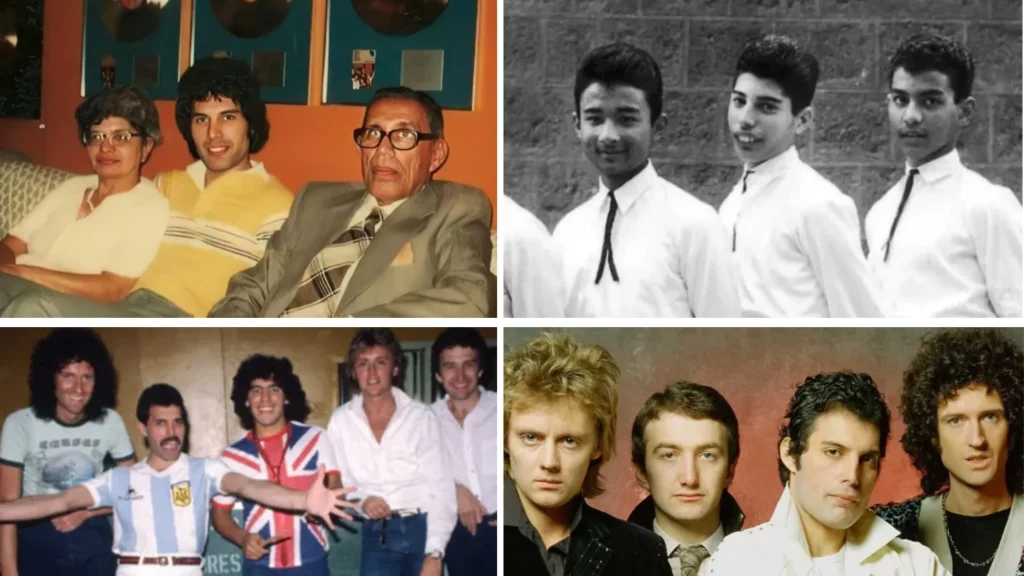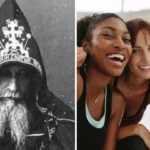November 24, 2022, marked the 31st anniversary of the death of Freddie Mercury, lead singer of Queen and one of the biggest music stars of the 20th century. His powerful voice, his movements on stage and his easy-going personality won him the appreciation of millions of fans around the world. However, his life was not exempt from controversies, mysteries and scandalous notes. Discover with us 45 curious facts and secrets about Freddie Mercury’s exotic life.
Real Name
Freddie Mercury’s real name was Farrokh Bulsara. His parents, Bomi and Jer Bulsara, were Parsees from India. Following an order from the British Colonial Office, the couple moved to the island of Zanzibar, where the artist was born on September 5, 1946.
It is known that Mercury always disliked his name. Given the difficulty of pronouncing it correctly, his fellow boarding school students at Panchgani began calling him “Freddie”. The “Mercury” would come from a verse of his song “My Fairy King”.
An Ancient Religion
Because of their Parsi origin, the entire Bulsara family (including Freddie himself) were followers of Zoroastrianism, whose central figure, Zoroaster, was considered the first and greatest prophet in history. It is a religion born in ancient Persia (now Iran) that also enjoyed a strong presence in India.
In fact, Zoroastrianism is one of the oldest monotheistic religions in the world, and in its time exerted a remarkable influence on other later religions, such as Islam, Christianity and Judaism.
Affluent Childhood
Freddie’s father, Bomi Bulsara, worked as a cashier for the British High Court, which is why he traveled frequently between India and Zanzibar. On the other hand, this job would allow them to become British nationals and enjoy the corresponding privileges.
The father’s good earnings allowed Freddie to enjoy an affluent childhood. They lived in a beautiful apartment in the Stone Town neighborhood of Zanzibar’s historic district, a place full of stores and bazaars overlooking the Indian Ocean.
The Nanny
Another of the privileges of the Bulsara family was the possibility of having a good number of domestic servants. In fact, the child Freddie was in the care of Sabine, a nanny whose face is able to convey all the severity of the trade.
But beyond the surviving photographs, very little is known about Sabine. We are left with the consolation of imagining that it was she who heard the first babblings of one of the greatest voices in rock history.
Philatelic Passion
Even before music, one of young Freddie Mercury’s earliest passions was collecting postage stamps from both Zanzibar and the United Kingdom and even various British colonies. The philatelic passion lasted about three years, from the age of nine to 12.
The Freddie Mercury stamp collection was acquired by the Postal Museum in London in 1993. Since 2016 it has been displayed alongside the collection of another British rock legend – John Lennon.
The Hectics
Within St. Peters College, Freddie Mercury had his first contacts with music. He learned to play the piano, to compose songs and began to sing. In fact, in 1958 he put together his first band, The Hectics, which played at private events at the institution.
The other members of The Hectics were Farang Irani, Victory Rana, Derrick Branche and Bruce Murray. The latter was the only one other than Freddie to pursue a musical career. The band disbanded in 1962, the year Freddie returned to Zanzibar.
Flight to England
In 1963 a series of social and political conflicts would begin in Zanzibar that would lead to the so-called “Zanzibar Revolution”. The African revolutionaries sought to overthrow Sultan Jamshid bin Abdullah and form an autonomous government.
In the midst of this tense climate, the Bulsara family decided to move to England when Freddie was 17 years old. They settled in a small house in the county of Middlesex. The parents would have a hard time adjusting to their new life, but Freddie had arrived in the land that would see him make history.
Bitter Past
In the few interviews he gave, Freddie Mercury was always reluctant to talk about his childhood and youth in Zanzibar. His answers on the subject were vague and denoted the little affection he felt for his birthplace.
It is clear that for Freddie it was of vital importance to maintain a separation between his intimate life and his artistic career. On the other hand, many speculate that this estrangement was due to the impossibility of showing his true personality in the strict social and religious environment of Zanzibar.
A Museum
Despite this, Freddie Mercury has become a beloved figure in his homeland. In fact, it was precisely in Zanzibar that the world’s first museum dedicated to the life of one of the greatest stars in rock history was inaugurated in November 2019.
Located in Stone Town, The Freddie Mercury Museum focuses on the singer’s early years. In the wake of the coronavirus pandemic, the museum has temporarily closed its doors, but they hope to resume offering guided tours soon.
Parallel Sportsman
Freddie told how, when he was still a young school student, he enjoyed playing certain sports. And that, moreover, he had great skills for them. For example, table tennis, field hockey and boxing. He commented that he was brilliant in the ring.
On the other hand, he was not at all fond of some typical English games, such as soccer or cricket. Perhaps, if Mercury’s musical career didn’t take off, there could have been a historical boxer with a privileged throat.
Pianist of Atypical Places
Even musical geniuses can come to doubt their talent if they are not confident enough. This happened to Freddie Mercury when he had a piano in front of him. He never really considered himself a virtuoso pianist.
However, he did compose his songs through that instrument. He had a piano near his bed, to compose the songs that came to his mind when he was dreaming. It is even said that he composed “Crazy Little Thing Called Love” in the bathroom, with a piano over the bathtub.
Mercury vs. Bowie
Freddie Mercury once helped David Bowie when Bowie was going to give a concert at the university and did not have the necessary equipment to start the performance. Some time later, Mecury and Bowie would end up collaborating on the song “Under Pressure”.
But as you might expect, it wasn’t all roses. Due to the strong personalities of both artists there were confrontations between them during the recordings. Fortunately, Bowie later always expressed a deep admiration for Freddie Mercury.
Always Inspired
Freddie’s talent was not only in his voice. He was the main composer of Queen songs, along with Brian May. Anyway, he was open to receive recommendations and ideas from the rest of the band.
Mercury’s inspiration could strike at any moment, and he didn’t plan to waste any of those instants, so his assistants carried pens and notebooks at all times. For example, the song “Life Is Real,” dedicated to John Lennon, was written during an airplane flight.
Dental Defect
Another of Freddie Mercury’s most notorious traits was his huge, protruding teeth, the product of four extra teeth pushing out the others. Mercury had a hard time overcoming his complex about his strange teeth; in fact, he was often seen with his hand over his mouth, in an attempt to hide this dental defect.
He also famously feared dental visits. She preferred never to align her teeth for fear of ruining her wonderful voice or losing vocal tessitura.
Mercury vs. Vicious
One of the most heated rivalries in rock history began in a recording studio, between Freddie Mercury and Sex Pistols bassist Sid Vicious. The confrontation between the two began with a perfidious comment from Vicious: “Have you managed to bring ballet to the masses yet?”
The comment alluded to the ballet slippers Mercury used to wear. In a way it was also a mockery of his effeminate mannerisms. Mercury was extremely annoyed, grabbed him by the shoulders and dragged him out of the studio.
The Infiltrator
This anecdote is told by actress Cleo Rocos. According to her own words, in 1988 she managed to infiltrate Princess Diana to the gay bar Royal Vauxhall Tavern, where both of them, along with Freddie Mercury and comedian Kenny Everett, ended up watching the famous series The Golden Girls.
A leather jacket and hat were enough for Lady Di to enter the venue unnoticed. Given Princess Diana’s personality, this story is not so far-fetched and is, to some extent, quite believable.
A Constant Performer
In addition to music and dancing, Freddie enjoyed other artistic attractions, such as painting. His house was filled with works of art, he even had a Picasso painting in the bathroom. He frequently attended auctions where he acquired different works and collected them. He had a special fondness for Japanese antiques.
All this artistic influence was inspirational for his music. For example, the song “The Fairy Feller’s Master-Stroke”, from the album “Queen II”, was composed after seeing a painting in the Tate Gallery in London.
Posthumous Gift
One habit Freddie Mercury had with his close friends was to call each other by feminine nicknames, worthy of drag queens. For example, Elton John, who was a close friend of Mercury’s, was called “Shanon” by him.
During the Christmas after Mercury’s death, Elton John received a package as a gift. The package contained a pillow that had belonged to Freddie, and was accompanied by a dedication: “Dear Sharon, I thought you might like to have it. Love, Melina. Merry Christmas.”
Unpleasant Pets
Among the many collaborations throughout Freddie Mercury’s career, his songs with none other than Michael Jackson, the undisputed King of Pop, stand out. These two songs are “There Must Be More To Life Than This” and “State Of Shock”.
Between the two there was very good harmony, and it is strange that there were not more collaborations. Some versions point to a disagreement produced by Freddie’s addictions, and others blame it on Michael’s unpleasant pets, whose presence on the set irritated Mercury.
Nose, Teeth and Hair
It seems incredible just to think about it, but for one night in the 1980s a rock band consisting of Rod Stewart, Elton John and Freddie Mercury came close to existing. Even a name was chosen for it: Nose, Teeth & Hair, in reference to the characteristic features of each musician.
However, it all ended at dawn, when the euphoria of the night passed. The musicians thought better of it and believed they couldn’t sing with each other.
Eternal Love
Freddie Mercury’s last partner was stylist Jim Hutton. They loved each other with such intensity that they even wore wedding rings, even at a time when equal marriage seemed a distant utopia.
When Mercury confessed to Hutton that he was an HIV carrier, he told him he understood if he would rather quit. Hutton’s words were truly poignant: “I love you, Freddie, I’m not going anywhere.” Hutton also contracted HIV and ended up passing away from lung cancer in 2010. The memoir “Mercury and Me” discusses their relationship.
Up in Arms
It is well known that Freddie Mercury was one of those who would not be run over by anyone, morally or physically. Someone who knew this very well was the leader of the band Status Quo, Francis Rossi, with whom Mercury had a disagreement during the 1985 Live Aid concert.
Rossi apparently made some jokes about Mercury’s sexual orientation. Mercury jumped on him and pinned him in a headlock. But all indications are that no hard feelings remained between the two, as the two bands played together a few years later.
Crossover
Like all great artists, Freddie Mercury was a man who lived his era to the fullest, and assimilated the elements of pop culture very well. Absolutely memorable was the concert in which Mercury walked out on stage on the shoulders of a guy dressed as Darth Vader.
The colorful crossover was rooted in a snippet of the song “Bicycle Race” that goes “I don’t like Star Wars.” But after Star Wars the nods to other American cultural references continued in their presentations, such as Superman or Santa Claus.
A Day to Celebrate
Every year, every September 5, Freddie Mercury Day is celebrated in the town of Montreux, Switzerland. The statue of Mercury there is considered a place of worship and pilgrimage for all lovers of Queen and her music.
Why this particular city? Basically because Mercury lived there for a while until shortly before his death and also because the original Queen studio was located there. Several of the band’s most iconic albums were recorded in Montreux.
Taste for Ballet
We have made reference to the fact that Freddie Mercury used to wear ballet slippers, but the truth is that he was also a lover of this particular style of dance. In fact, he came to perform the public on an occasion that remained for the history.
It happened in 1977, when Wayne Eagling, a principal dancer with the Royal Ballet, organized a ball to raise money for charity. Mercury appeared on stage and did a spectacular number. The choreography he performed was planned by Eagling exclusively for him.
Olympic Mercury
One of the artists most admired by Freddie Mercury was the Catalan soprano Monserrat Caballé. He himself acknowledged this in an interview he gave for Spanish television during the 1980s.
Luckily for fans of good music, Mercury and Caballé would end up meeting and making a legendary collaboration. It was the song “Barcelona,” an anthem of its time that would later, in 1992, become the official theme song of the Olympic Games.
The Circuit Does Not Include Broadway
Thanks to his majestic voice, Freddie’s career could have had hundreds of different nuances and collaborations. He even came close to starring in La Bohème, a Broadway musical, alongside popular singer Linda Rondstand.
But Mercury rejected the proposal. He clarified that, although he enjoyed going to the theater, ballet and opera, doing a whole season would bore him. He also commented that he would run out of energy. It seems that the rock and roll life was a better fit for him.
Mercury and Maradona
In 1981 Queen began a tour of Latin America, a territory that was not a frequent destination for European rock bands. Freddie Mercury and his bandmates were eager to take their music to new places where they were unsure how they would be received.
The tour was a resounding success. In Argentina, soccer star Diego Armando Maradona attended the concert and personally thanked Mercury for his music. Maradona and Mercury exchanged jerseys and spent some time laughing.
Leaving it All On the Stage
Freddie’s eccentric personality, which made him one of the most admired artists in history, led him to generate extreme situations. The singer tried to channel emotional conflicts through a higher level of adrenaline in his shows.
So it is that, in the run-up to a 1982 performance in London, he argued with Bill Reid, partner at the time, and the latter bit his hand until he made it bleed. It is believed to have been one of the best concerts in Queen‘s life.
The Final Single
Significantly named “The Show Must Go On”, Queen‘s final single would see the light of day just a few weeks before Freddie Mercury’s death in late 1991. By the time of the recording Mercury was already seriously ill and it was uncertain whether he would be able to sing.
In order to give himself the necessary strength, Mercury ingested a mixture of vodka and other alcoholic beverages and recorded the final version in one take. Snippets of old live video clips were used as a video accompaniment.
Permanent Conflicts
Despite having been together for so many years, the truth is that infighting and arguments were constant in Queen. To a certain extent it is normal for artists of such caliber to have differences when it comes to agreeing on certain issues.
It is known the incident in which Freddie Mercury had to mediate between Brian May and Roger Taylor so that these did not come to blows. Mercury himself once stated that this tense atmosphere was key to the band’s success.
Solo
An addition that caused even more concern about the future of Queen was Freddie Mercury’s solo venture. The singer spent two years in Munich, Germany, composing his first solo album, which would be titled Mr. Bad Boy.
It was rumored that the new album would compete in sales with “The Works”, the album that Queen released around the same time. However, from this solo experience only “Living On My Own” is considered a hit song.
Unique Style
Freddie Mercury’s style was transgressive and unparalleled. He renewed the rock scene and added a theatricality that, until then, the genre lacked. On the other hand, his flamboyance and irreverence earned him artistic immortality.
Feathers, sequins and low-cut T-shirts were part of Mercury’s usual look, in addition to the multiple costumes he came to wear at concerts. An atypical outfit for a rock star, but one that helped him stand out and leave his mark on the history of music.
Success and Censorship
Freddie’s work, like that of many transgressive artists, also suffered moments of censorship. As he became an icon of the gay community, much more marginalized at the time, the authorities began to pay attention to his messages.
Among the details of his work that suffered censorship is the video of one of his most successful songs: “I Want to Break Free”, where a parody of the British soap opera Coronation Street is made. On the MTV channel in the United States, the video was broadcast only in 1991.
A Historic Concert
Held in 1985, the event called “Live Aid” consisted of two simultaneous concerts, one in London and one in the United States, organized in order to raise funds to fight famine in some African countries. Artists such as U2, Elton John and Led Zeppelin were part of the party.
Nevertheless, it is a unanimous truth that Queen hogged all the limelight. Freddie Mercury’s performance was absolutely legendary and inspiring, and today it is considered the greatest Queen performance of all time.
Record Number of Spectators
Another historic concert took place in Rio de Janeiro, Brazil, that same year. The mythical Maracana stadium, home of some of the most remembered sporting events in history, was the stage chosen by Queen to bring their music to the country of samba.
It is estimated that approximately 250,000 spectators attended the concert that day to see Freddie Mercury’s magic up close. The band always claimed that it was the first time in the history of music that a group gathered such an audience.
The Oldest Fans
The band Queen has a particular record, which is even in the Guinness Book of World Records. It is the longest-running fan club in history. It was created in the mid-1970s, to provide and disseminate information about the band.
With more than 40 years of existence, it remains active until today and its manager, Jacky Smith, is a reference for all Queen fans. But also for whoever intends to manage a club in honor of their idols.
A Group of Records
The band led by Freddie is the protagonist of a cataract of historical records for music. Many of which, even today, are hard to beat. One of them has nothing to do with the number of people in a show or records sold, but with the composition.
Queen is the only rock band in which every member composed a song that topped the charts.
The Last Concert
Queen closed the Magic Tour on August 9, 1986 with a concert at Knebworth Park. By that time no one could have suspected that it would be the last time the great rock star, Freddie Mercury, would sing in front of a crowd.
A total of 125,000 people had the privilege of enjoying Mercury’s last live show. The image of the members of Queen arriving by helicopter directly to the stage to show off the best of their repertoire is still remembered.
Some Problems
As with many artists, one of Freddie Mercury’s most controversial facets was his addictions to drink, psychoactive substances and so on…. In fact, it was very common to see him getting drunk at his many parties.
Of course, the consumption of narcotics brought more than one problem to the singer, such as the breakup of relationships with friends and close ones. Mercury’s libertine life had several excesses that would end up taking its toll not only on his personal life but also on his health.
Rumors About His Health
Rumors about Freddie Mercury’s health condition started in the year 1987, one year after his live show. His absence from the stage and some comments from his boyfriend, Jim Hutton, suggested that the singer could be ill with AIDS.
Being a disease that spread rapidly in those years, and about which there were important prejudices, Mercury preferred to deny in an interview that he suffered from it. In the end, however, he ended up admitting he had AIDS the day before he died.
Musical Refuge
It is likely that Mercury could have done more to treat his illness. Of course, knowledge about AIDS was not the same at the time. However, during his deterioration he only took common painkillers and was denied other medication.
Freddie’s real therapy was music. Guitarist Brian May recounted that he was obsessed with songwriting. He didn’t fear the disease, but he did constantly ask him to write songs so he could sing.
A Sad End
Freddy Mercury died in his mansion, in London, on November 24, 1991, at the age of 45. The cause of death was bronchopneumonia resulting from complications with AIDS. His family, close friends and some artists were present at the funeral ceremony.
One of the mysteries that still remains around Mercury’s death is the place where his ashes rest. On the other hand, the substantial fortune he amassed during his lifetime was divided between his friend Mary Austin and next of kin.
The Show Must Go On
Freddie Mercury’s last song was “The Show Must Go On”, and the truth is that Queen continued their activity without him. In 1995 “Made in Heaven” was released, the band’s fifteenth album, featuring the songs Mercury recorded during his final years.
After Mercury’s death and John Deacon’s retirement in 1997, Roger Taylor and Brian May decided to continue working and keep the Queen name. Currently they still play, but without Mercury’s magic things are not the same.
Two Legacies
There are two important legacies that a star like Freddie Mercury has left to the world. The first is undoubtedly his music, his uninhibited style and his prodigious voice. All this has served as inspiration for millions of people around the world.
The second has to do with activism on behalf of AIDS patients. It may not be understood today, but at the time it was almost impossible for a celebrity to admit to having the disease. Mercury’s confession served to make visible a problem that still continues.
Voices From Beyond
In 2014, when more than 20 years had passed without Freddie, Brian May and Roger Taylor decided to release an unreleased song that featured his vocals. The track was unfinished, but it held a vocal record of the singer, which they decided to present to the world through an AIDS awareness campaign.
So it was that “Let Me In Your Heart Again” was released, a new Mercury song, released decades after his physical demise and reconnecting his majestic voice with fans’ nostalgia.
It Went All the Way to Grunge
The number of musicians and artists who found inspiration in Mercury’s voice and work are beyond counting. In the decades following his existence, dozens of rock subgenres emerged. Among the most important, American grunge.
His top man, Kurt Cobain, revealed that he had great admiration for Freddie. Especially for his ability to relate to the public and feel loved. Something he could not achieve, as he told in his farewell letter.
The Show Does Go On
It is impossible to know how Freddie’s relationship with new technologies would be. Especially with social networks. But we do know that his music has adapted very well and does not lose its relevance. On the contrary: in 2019, the video of “Bohemian Rhapsody” became the first music hit before 1990 to reach one billion views on YouTube.
The song, which is nearing its half-century anniversary, continues to break records no matter what platform it’s on.
Conquering Even Space
In 2016, the year the singer would have turned 70, a very special, and quite unique, gift was made. An asteroid, located in the belt that lies between Mars and Jupiter, was named “17473 Freddiemercury”, in honor of the great influence his figure had on the world.
It was announced by guitarist Brian May, who is also an astrophysicist, through a video. Another record for Freddie: the first artist to conquer outer space.
New Tours
Since 2005 Taylor and May have done several tours that seek to revitalize the Queen name. For this they have used the pre-recorded voice of Freddie Mercury. They have also made collaborations with different singers, such as Paul Rodgers and Adam Lambert.
They are currently on a tour called “The Rhapsody Tour”, which seeks to capitalize on the success of the Bohemian Rhapsody biopic. The pandemic-hit tour is scheduled to end in 2022.
The Movie
If there was one thing Freddie Mercury fans were waiting for, it was a movie that would honor the life and work of the man who was considered by many to be the greatest singer of the 20th century. This dream came true in 2018, with the release of Bohemian Rhapsody.
The film received rave reviews, and even won the prestigious Golden Globe in the Best Motion Picture Drama category. Particularly celebrated was the performance of Rami Malek, who played Mercury, and received an Oscar for his excellent role.




























































